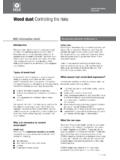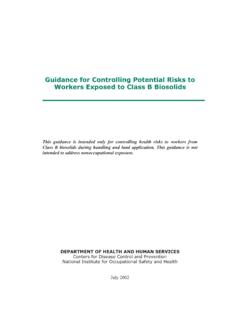Transcription of Controlling the risks of infection at work from …
1 Health and Safety Executive Controlling the risks of infection at work from human remains A guide for those involved in funeral services (including embalmers). and those involved in exhumation Controlling the risks of infection at work from human remains Contents WHAT IS THIS GUIDE ABOUT? 1. WHAT DO I HAVE TO DO? 2. IDENTIFYING THE HAZARD 5. Sources 5. Transmission 5. Host 6. ASSESSING THE risks 7. Controlling THE risks 10. Cleaning, disinfection and disposal of waste 16. APPENDIX 1. Part 1: Key infections 18. Part 2: Additional infection information for exhumation 19. Part 3: Special precautions when a smallpox- infected body is suspected 20.
2 APPENDIX 2: infection CONTROL. NOTIFICATION SHEET 22. APPENDIX 3: DISINFECTANTS AND. DISINFECTION 23. APPENDIX 4: FURTHER READING AND. INFORMATION 26. Controlling the risks of infection at work from human remains What is this guide about? 1 This guide deals with the risk of infection when dealing with human remains. It provides advice for: funeral directors and their staff, including part-time/casual workers and the self- employed, for example trade embalmers'; and those involved in exhumations, for example cemetery employees, specialised companies, the Police, Environmental Health Officers (EHOs), archaeological researchers and redevelopment/construction companies, about the sorts of risks they face and how to control them.
3 Although the term your employees' is used throughout, the duties etc described apply equally to you as an individual if you are self-employed. 2 The guide covers your duties under health and safety law as they relate to Controlling the risks of infection , in particular the Control of Substances Hazardous to Health Regulations. You may already know that these regulations deal with chemicals risks at work but they also cover infection risks (from micro- organisms) too. 3 Information about other relevant guidance on infections risks and other health and safety risks , for example chemical, manual handling, construction, that are an issue in the funeral/exhumation process can be found in Appendix 4: Further reading and information.
4 Did you know? In England, though the major infectious diseases are responsible for the death of only a small number of people compared to the past, infection still accounts for 70 000 deaths each year. You should also be aware that although infection may not have been the cause of death (as officially recorded), individuals may have either had an infectious illness at the time of death or else have been infected without showing any obvious signs or symptoms. The Home Office issues over 1000 licences for the exhumation of individual human remains each year. Most exhumations are planned, but some will result from an accidental disturbance in road or building construction.
5 The main reasons for planned exhumations are: redevelopment of old cemeteries or crypts, often with associated archaeological investigations;. medical/criminal investigations;. individual requests for exhumation from family or relatives for reburial or cremation; or archaeological reasons. 1. Controlling the risks of infection at work from human remains What do I have to do? 4 You can deal with the risks from infection in the same way as any other health and safety issue such as manual handling or chemical risks . You need to: identify the hazards;. assess the risks ; and control the risks . 5 In addition to the intentional contact with human remains that may occur, there may be circumstances where there is unintentional contact, for example accidental disturbance during an archaeological dig, or else where a body may be found by an EHO called to investigate an odour problem in a domestic setting.
6 The likelihood of such contact should be assessed, and appropriate controls used. 6 As well as considering the risks to your employees, you also need to decide whether the work that you do puts others at risk of infection , for example relatives who come to view the deceased, police officers attending an exhumation. You have a duty under health and safety law to protect these people too (see Information box 7). Information box 1: Working with contractors If you use a contractor, such as a trade embalmer or specialist exhumation company, to carry out work for you, you need to remember that you both have duties under health and safety law.
7 You may decide to address these responsibilities in a written contract of work, but both sides should be clear as to where responsibilities lie. You need to: check on their competence;. agree the risk assessment;. agree the controls that will be used, including how and where waste will be disposed, and how exposure to chemicals will be monitored;. provide information to the contractor about risks in your premises; and make sure the work is appropriately managed and supervised. Further guidance on the use of contractors can be found in HSE guidance (see Appendix 4: Further reading and information). 7 If someone working under your control and direction is treated as self- employed for tax and national insurance purposes, they may still be treated as your employee for health and safety purposes.
8 You may need therefore to take appropriate action to protect them. 8 If you do not wish to employ workers on this basis, you should seek legal advice. Ultimately each case can only be decided on its own merits by a court of law (see Information box 1). 2. Controlling the risks of infection at work from human remains 9 If you employ more than five people you must write down the significant findings of your assessment. You should record the significant hazards identified in your assessment, together with the controls that are in place or are to be used. If you have fewer than five employees, you do not need to write anything down but you may find it useful to keep a written record of what you have done.
9 10 Your risk assessment is a living document and should reflect any changes in the work that you do, new equipment that is used or a new work activity that is added, if this changes the risk or leads to new hazards being introduced. It is also good practice to review your assessment from time to time to make sure that the controls you are using are working and still appropriate. 11 If any of your employees catch an infection as a result of their work, these must be reported under the Reporting of Injuries, Diseases and Dangerous Occurrences Regulations. If you are self-employed, you still need to make a report. Information box 2: Other relevant legislation There are other regulations (not health and safety), which also deal with infection risks that you should consider.
10 Public health law: Doctors in England and Wales have a statutory duty to notify a 'proper officer' of the local authority of suspected cases of certain infectious diseases. There is also a requirement that those in charge of premises where there is a body of a person who died while suffering from a notifiable disease take reasonable steps to prevent others unnecessarily coming into contact with, or proximity of that body. Similar duties exist in Scotland, although the diseases that have to be notified are slightly different to those in England and Wales. Environmental protection law: Any waste which consists wholly or partly of human or animal tissue, blood or other body fluids, excretions, drugs or other pharmaceutical products, swabs or dressings, or syringes, needles or other sharp instruments, and any other waste arising from medical, nursing, dental, veterinary, pharmaceutical or similar practice, investigation, treatment, care, teaching or research, or the collection of blood for transfusion, which may cause infection to any person coming into contact with it is defined as clinical waste' (see paragraph 38).
















